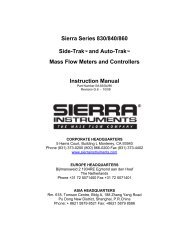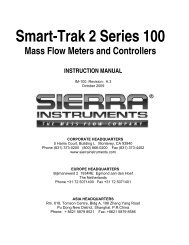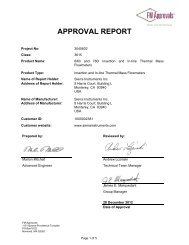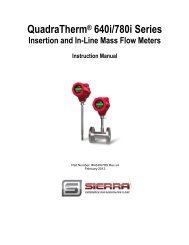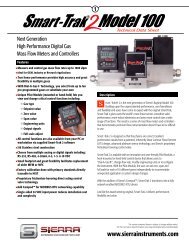Instruction Manual - Sierra Instruments
Instruction Manual - Sierra Instruments
Instruction Manual - Sierra Instruments
You also want an ePaper? Increase the reach of your titles
YUMPU automatically turns print PDFs into web optimized ePapers that Google loves.
<strong>Sierra</strong> <strong>Instruments</strong> <strong>Instruction</strong> <strong>Manual</strong>SmartTrak ® 100 SeriesInstalling the Instrument—PlumbingSmartTrak instruments are supplied with compression, VCO ® , VCR ® , or femaleNPT process connections. To ensure a successful installation, inlet and outlet tubingshould be clean prior to plumbing the instrument into the system. The shipping capscovering the inlet/outlet fittings should not be removed until immediately beforeinstallation.Follow the installation instructions that are applicable to your instrument’s processconnection. Ensure that the tubing is free from burrs or sharp rims that may resultfrom cutting.CAUTION: Before use, all plumbing should be checked carefully for leaks,especially at the connecting fittings. All instruments are leak-tested prior toshipping. It is not a requirement to leak test your instrument. Do not use liquidleak detectors such as Snoop ® to search for leaks inside or outside theSmartTrak. Instead, monitor pressure decay.Compression Fittings1. Position the instrument with the flowdirection arrow pointing in the directionof flow.2. Verify the position of the front and back ferrule. Insert the tubing into thefitting. Be sure that the tubing rests firmly on the shoulder of the fitting andthat the nut is finger-tight. Scribe the nut at the six o’clock position.3. While holding the fitting body steady with a backup wrench, tighten the nut1-1/4 turns, watching the scribe mark make one complete revolution andcontinue to the nine o’clock position. For 1/16-inch, 1/8-inch and 3/16-inch(2, 3 and 4 mm) sizes, tighten only 3/4 turns from finger-tight. Do not overtighten!4. If you use flexible tubing (Example: Polyflow) use an “Insert” (seewww.swagelok.com)5. Check the system’s entire flow path thoroughly for leaks. Do not use liquidleak detectors. Instead, monitor pressure decay. Exposing the instrument toleak detector fluid may cause damage.VCO Fittings1. Position the instrument with the flow direction arrow pointing in thedirection of flow.13



